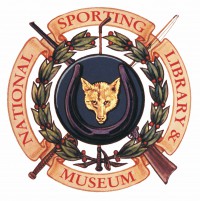Today’s highlight dates back to 1921, a memento of the high drama surrounding the polo match for the Westchester Cup that year. In the NSLM Archive collection is a photo album from the match, titled An International Polo Match. The album belonged to the prominent American sportsman, F. Ambrose Clark (1881-1964). Clark was a leader in equestrian sports of all kinds throughout his life; the Rare Book Room at National Sporting Library & Museum is named for him.

The photo album commemorates the eighth meeting between the English and American polo teams for the Westchester Cup, founded in 1876. The English won the cup in 1914 before competition was halted due to World War I. By the end of the war, the Americans were eager to bring the cup back to the United States, but a delay was necessary to give England time to recover from the conflict. By 1921, both sides were ready to compete for the first time in seven years.

Practice matches began in April 1921, with the English team rotating between players in an attempt to find their best four. The Americans had identified their team well in advance, and when practice matches began, the Americans only used the same four players.

The match was to be a best of three series, hosted by the Hurlingham Club. Shortly before the match, the Americans were invited to dine with King George V, although the captain of the team, Devereux Milburn, was unable to attend due to an attack of lumbago.

The English team gallantly requested that the game be postponed to accommodate Milburn’s ailment, but were declined by the Hurlingham Club (who pointed out that the Americans themselves had not requested a delay). Milburn recovered in time to take part in the matches.

The first match was won by the Americans, 11-4. The Americans got out in front early and never looked back. Teams were the same for both matches, with the Americans wearing white and the English wearing dark blue on both occasions.

The Americans carried the second match 10-6, ending the competition without a third meeting of the teams. The victory returned the Westchester Cup to America, and the many Americans who traveled to England to view the match celebrated the victory with gusto (polo historian Horace Laffaye in Polo In Britain describes the English as “bewildered” when the American men and women broke out into an impromptu conga line on the field to celebrate). The Westchester Cup would stay in American hands until 1997.
Would you like to make some polo memories of your own? You can this September at our 6th Annual Polo Classic! Tickets are on sale now. For details contact Alexandra McKay at AMcKay@NationalSporting.org.

John Connolly has served as the George L. Ohrstrom, Jr. Librarian at the National Sporting Library & Museum (NSLM) since early 2014. He is responsible for the care of the Library collections, including books, magazines, photographs, diaries, letters, and much more. The NSLM collections span over 350 years of the history of equestrian sport, as well as fly fishing, wing shooting, and other field sports. Have a question? Contact John by e-mail.
